Arizona Wild Flowers
Pictures, Photos, Images
Descriptions, Information, Reviews.
Superstition Mallow, Abutilon palmeri.
We Are Proud Of Our SafeSurf Rating!
Click On Any Of The Following Links By Amazon.Com
For Books, & Videos About Wildflowers Of Arizona & The Southwest USA. No Obligation!
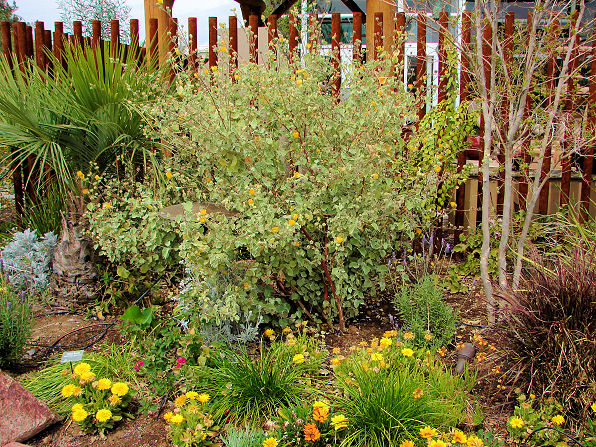 |
| Superstition Mallow. Abutilon palmeri. |
|---|
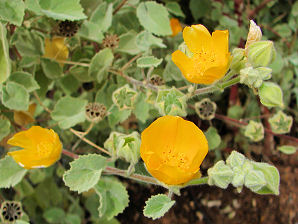 | 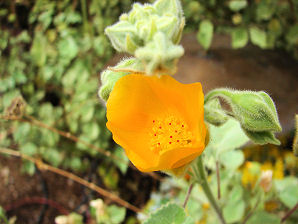 |
| Superstition Mallow. Abutilon palmeri. | Superstition Mallow. Abutilon palmeri. |
|---|---|
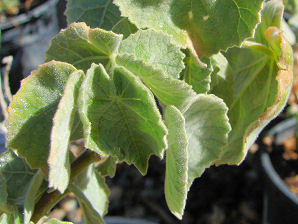 | 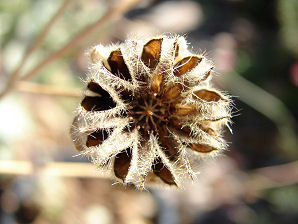 |
| Superstition Mallow. Abutilon palmeri. | Superstition Mallow. Abutilon palmeri. |
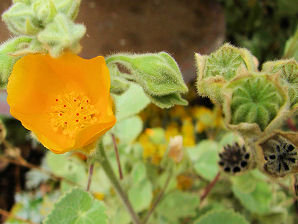 | 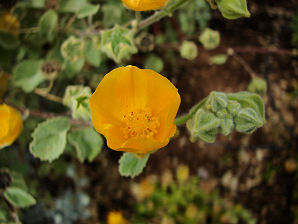 |
| Superstition Mallow. Abutilon palmeri. | Superstition Mallow. Abutilon palmeri. |
 /
/

Superstition Mallow.
We wish to thank Wikipedia, the free encyclopedia for some of the information on this page. We share images and information with Wikipedia. A medium herbaceous shrub growing up to 3 or 6 feet tall. It has a 3 to 5 feet spread. It is easly identified by it's velvety heart - shaped leaves. It's soft fuzzy leaves are light grey - green. These are leaves that you will enjoy touching. Superstition Mallow is best used as a background/filler plant in a flower bed and it can be pruned to just about any shape and height you wish. It also works well if you plant it next to a patio where you can enjoy its soft texture. Desert mallow blooms throughout the warm summer months with small, cup-shaped, apricot-colored blossoms. It will experience some foliage and stem damage when temperatures drop into the low 20's F. It can be cut back hard in early spring to remove damaged foliage. It needs very little water once established. It will grow faster with more water provided to it. Sun Exposure: Full sun to part shade, Tolerates reflected heat.
Quick Notes:
Height: Up To 3 - 6 Feet Tall. With a 3 - 5 feet Spread.
Flowers: Bright orange, but also occurs with yellow to light orange flowers. Flowers have 5 petals up to about 1 1/2 inches in width. They appear in clusters at the upper part of the stems.
Flowering Time: Year - Round, Especially April - May. They reflower from August to frost, in response to the summer rains.
Seeds: The globe - shaped seedpod, surrounded by the persistent calyx, separates at maturity into 7 to 22 kidneyshaped sections. Each section produces 1 to 3 kidney - shaped seeds about 1/16 inch long, very dark brown.
Leaves: Green to gray - green, 3-lobed, scalloped-edged leaves. 0.5-2.5" long, ovate, 3 shallow lobes, scalloped edges. The leaves are alternate and palmately veined.
Found: The USDA claims Abutilon palmeri is native of the USA (AZ, CA). In Arizona it is native to Yuma, Maricopa, Pima, & Cochise counties. Also native to northern Mexico in Sonora, & Baja California Norte.
Hardiness:
Soil pH requirements:
Sun Exposure:
Elevation: 0 - 2,500 feet.
Habitat: Hillsides, Roadsides, Flats, Sandy Plains. In towns they are largely confined to roadsides, borders of cultivated lands, fields, sidewalks, vacant lots, and drainage areas. Any well draining soil, dry, especially east facing slopes.
Miscellaneous: Flowering Photos Taken February 22, 2006. Glendale, Arizona
|



We Are Proud Of Our SafeSurf Rating!
Click On Any Of The Following Links By Amazon.Com
For Books, & Videos About Xerioscape Plants Of Arizona & The Southwest USA. No Obligation!
Back To Arizona Wild Flowers Home Page.
Back To Arizona Wild Flowers; Orange Flowers Page Two.
Back To Arizona Xeriscape Landscaping Main Page.
Back To Xeriscape Shrubs Page Three.
Back To DeLange Home Page
© 1966 - Present, Audrey, Eve, & George DeLange
| © 1966 - Present, Audrey, Eve, & George DeLange |


